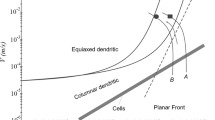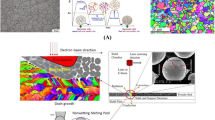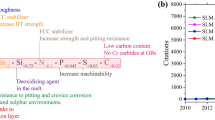Abstract
Manufacturing diamond wheels on various bonds is a relatively high-cost process, requiring high labour and high consumption of expensive diamond grains but yielding relatively low productivity. With better knowledge of the various factors involved in the sintering process, the most efficient combinations can be found, leading to higher productivity. Currently, there are no scientifically based recommendations for the choice of the rational combinations of strength, brand of grain, graininess and concentration with the physical–mechanical properties of bonds. The aim of this research is the development of a technique for the theoretical definition of an optimal combination of strength properties of diamond grains and bond to provide maximum retention of diamond grain integrity during the process of diamond wheel manufacture. This is investigated using 3D simulations of the deflected mode of the sintering area of the wheel's diamond-bearing layer.
Similar content being viewed by others
References
Mamalis AG, Grabchenko AI, Fedorovich VA, Kundrak J (2009) Methodology of 3D simulation of processes in technology of diamond-composite materials. Int J Adv Manuf Technol 43:1235–1250
Heisel U, Krivoruchko DV, Zaloha VA et al. (2007) "Cause Analysis of Errors in FE Prediction Orthogonal Cutting Performance", Proceedings of the 10th CIRP International Workshop on Modeling of Machining Operations, Calabria, pp. 141–148
Sohne J (2003) Beitrag zur Simulation zerspanungstechnologischer Vorgange mit Hilfe der Finite-Element-Methode. Universitat Karlsruhe, Karlsruhe, p 162
Sartkulvanich P (2005) Effects of flow stress and friction models in finite element simulation of orthogonal cutting—a sensitivity analysis. In: P. Sartkulvanich, T. Altan (Eds) Machin Sci Technol (9):1–26
Mamalis AG, Kundrák J, Markopoulos A, Manolakos DE (2009) On the finite element modeling of high speed hard turning. Int J Adv Manuf Technol 38:441–446
Klocke F, Lung D, Gerschwiler K et al. Scaling Effects of the Cutting Edge Rounding on the Minimum Uncut Chip Thickness and 3D FE Modeling in Drilling, Proceedings of the 10th CIRP International Workshop on Modeling of Machining Operations. pp. 197–208
Guo YB, Liu CR (2002) 3D FEA modeling of hard turning. J Manuf Sci Eng Trans ASME 124:189–199
Denkena B, de Leon Garcia L, Köhler J (2007) FEM-Simulation of High-Performance-Milling, Proceedings of the 10th CIRP International Workshop on Modeling of Machining Operations, pp. 149–156
Dix M, Leopold J, Neugebauer R, (2007) Investigations on the Influence of Local Material Properties of Burr Formation, Proceedings of the 10th CIRP International Workshop on Modeling of Machining Operations, pp. 133–140
Semko MF, Grabchenko AI, Khodorevskiy MG (1980) Diamond Grinding of Synthetic Superhard Materials. Vyscha shkola, Kharkov, p 192
Grabchenko AI, Fedorovich VA (2008) 3D Simulation of Diamond-Abrasive Processing: Monograph. National Technical University "Kharkov Polytechnic Institute, Kharkov, p 376
Gargin VG (1983) "Influence of Inclusions in Diamonds on the Strength", Journal "Superhard Materials", Kiev. - No 4
Grabchenko AI, Fedorovich V, Fedorenko D et al. Improvement of diamond-abrasive tools based on 3D – simulation, Proceedings of the XXIV International Scientific Conference "MicroCAD - 2010". - March 18–20. Miscolc. – 2010, pp. 63–68
Voronin GA, Mal’nev VI, Nevstruev GF (1984) Influence of Inclusions on Strength of Synthetic Diamonds at High Temperature, Journal "Superhard Materials", Kiev. - No 2, pp. 33–37
Novikov NV, Maistrenko AL, Kulakivskiy VN (1993) Fracture Strength of Superhard Composite Materials. Naukova Dumka, Kiev, p 220
Author information
Authors and Affiliations
Corresponding author
Rights and permissions
About this article
Cite this article
Mamalis, A.G., Grabchenko, A.I., Fedorovich, V.A. et al. Simulation of effects of metal phase in a diamond grain and bonding type on temperature in diamond grinding. Int J Adv Manuf Technol 58, 195–200 (2012). https://doi.org/10.1007/s00170-011-3382-7
Received:
Accepted:
Published:
Issue Date:
DOI: https://doi.org/10.1007/s00170-011-3382-7




